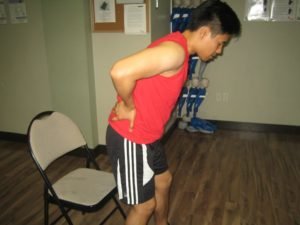Lumbago or pain in the low back is characterized as mild to intense pain or discomfort. The pain can be acute or chronic if it persists for more than 3 months. Many individuals suffer from lumbago at some point in life. It can manifest at any age but quite common among young individuals whose work involves physical exertion and also among the elderly.
The pain or discomfort often settles within a few weeks but it can be a persistent issue for some individuals.
What are the usual causes?
In most cases of lumbago, it is difficult to pinpoint the exact cause. There is a possibility that there are miniature tears in some muscles and ligaments which is hard to pinpoint within the complex structure of the back.

In some cases, there is a specific issue particularly conditions such as the following:
- Arthritis
- Slipped disc
- Fracture of one or several vertebrae
- Deformity of the spinal curvature
- Damage from tumors or infection
Indications of lumbago
- Pain over the lower region of the back that oftentimes spreads to the buttocks, back of the thigh or the groin. The pain is usually aggravated by movement.
- Diminished movement of the spine particularly when bending forward and leaning back.
- Strained muscle spasms surrounding the spine that results to a stiff back.
- If there is intense pain and spasms, the back might tilt to one side which results to a change in the posture or a limp.
- The pain can be accompanied by a tingling sensation or numbness in the buttocks, back or leg that might go down into the foot.
What are the warning indications?
- Individual could not control his/her bladder or bowel movements
- Area in the lower back or legs abruptly weakens or turns numbs
- Back pain with diminished strength or muscle bulk in one or both legs
These warning signs might indicate damage to the spine which might be causing the compression of the spinal cord and/or nerves that branches out from it. Remember that prompt treatment is vital to avoid lasting damage.
Treatment measures to ease lumbago at home
- Provide pain medications or consult a doctor so that medications that relax the back muscles can be given. Non-steroidal anti-inflammatory drugs (NSAIDs) and muscle relaxants can ease the pain better.
- Try to stay active as much as possible to keep the muscles supporting the spine strong as well as prevent the formation of scar tissue and cause rigidity.
- Provide warmth using a warm compress or apply a capsaicin-based heat cream.
- Encourage the individual to rest on a flat, firm surface.
- Instruct the individual to avoid bending, stooping, lifting and sitting on low chairs.
